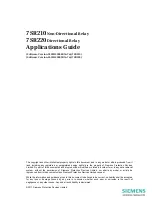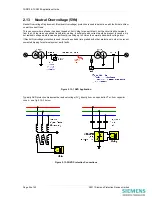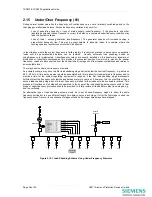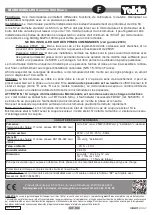
7SR210 & 7SR220 Applications Guide
2.4
Instantaneous Overcurrent (50/50G/50N)
Each instantaneous element has an independent setting for pick-up current and a follower definite time lag (DTL)
which can be used to provide time grading margins, sequence co-ordination grading or scheme logic. The
“instantaneous” description relates to the pick-up of the element rather than its operation.
O
per
ating
time
Figure 2.4-1 General Form of DTL Operate Characteristic
Instantaneous elements can be used in current graded schemes where there is a significant difference between
the fault current levels at different relay point. The Instantaneous element is set to pick up at a current level above
the maximum Fault Current level at the next downstream relay location, and below its own fault current level. The
protection is set to operate instantaneously and is often termed ‘Highset Overcurrent’. A typical application is the
protection of transformer HV connections – the impedance of the transformer ensuring that the LV side has a
much lower level of fault current.
The 50-n elements have a very low transient overreach i.e. their accuracy is not appreciably affected by the initial
dc offset transient associated with fault inception.
2.4.1
Blocked Overcurrent Protection Schemes
A combination of instantaneous and DTL elements can be used in blocked overcurrent protection schemes.
These protection schemes are applied to protect substation busbars or interconnectors etc. Blocked overcurrent
protection provides improved fault clearance times when compared against normally graded overcurrent relays.
The blocked overcurrent scheme of busbar protection shown in Figure 2.2-2 illustrates that circuit overcurrent and
earth fault protection relays can additionally be configured with busbar protection logic.
The diagram shows a substation. The relay on the incomer is to trip for busbar faults (F1) but remain inoperative
for circuit faults (F2).
In this example the overcurrent and earth fault settings for the incomer 50-1 element are set to below the relevant
busbar fault levels. 50-1 time delay is set longer than it would take to acknowledge receipt of a blocking signal
from an outgoing circuit.
Close up faults on the outgoing circuits will have a similar fault level to busbar faults. As the incomer 50-1
elements would operate for these faults it is necessary to provide a blocking output from the circuit protections.
The 50-1 elements of the output relays are given lower current settings than the incomer 50-1 settings, the time
delay is set to 0ms. The output is mapped to a contact. The outgoing relay blocking contacts of all circuits are
wired in parallel and this wiring is also connected to a BI on the incomer relay. The BI on the incomer relay is
mapped to block its 50-1 element.
©2011 Siemens Protection Devices Limited
Page 15 of 40
















































